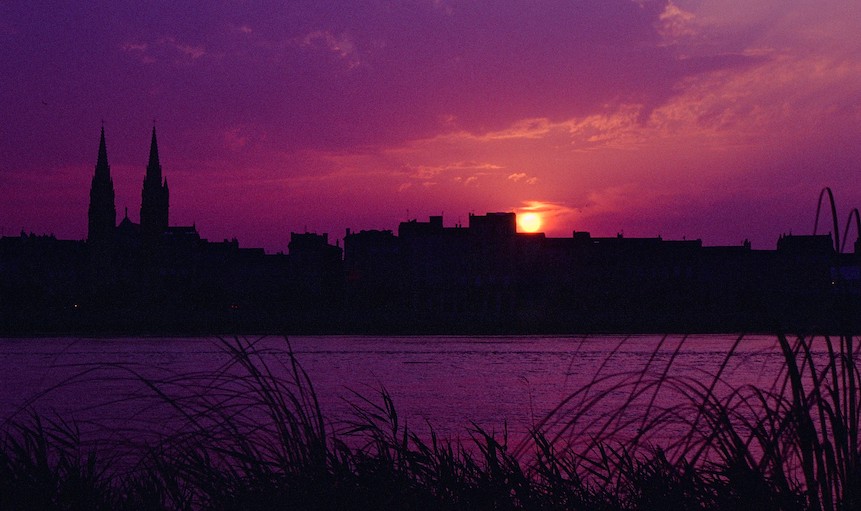
Sunset over the Lot River in Nouvelle-Aquitaine. Photo by Nancy Wigston
By Nancy Wigston
East of the wine-making capital of Bordeaux and north of the Canal de Garonne lies the River Lot, the seventh longest in France. Every day vacationers fresh off the fast train from Paris hop aboard boats on the Lot bound for a romantically medieval landscape that once belonged to English kings.
Legendary figures like Richard the Lionheart grew up here, and his Plantagenet parents, Eleanor of Aquitaine and Henry II, are buried here. Only after the brutal 100 Years War and the coming of a peasant girl called Joan of Arc were French kings able to dislodge the English and incorporate the Aquitaine (now called Nouvelle-Aquitaine) into what later would become modern France.
The Aquitaine is enormous. An amalgam of three former regions, it spans the west and southwest of the country, bordering Spain, the Pyrenees mountains, and the Atlantic coast.
A river trip on the Lot is a voyage through 800 years of history. Self-drive boats for hire come with modern conveniences: sparkling kitchens, hot showers, neat bedrooms and air conditioning. Steering and docking are easily mastered and those few who get stranded ashore are quickly rescued by company employees.
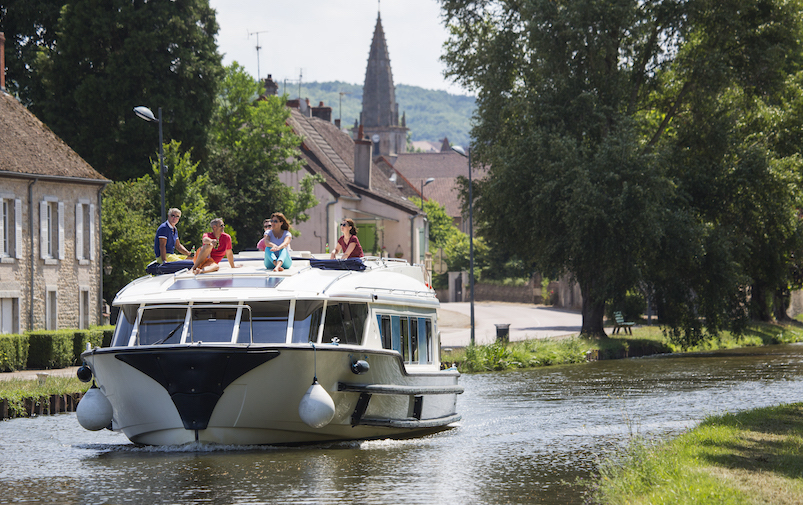
Nicely furnished like this one from Le Boat cruise the Lot and other rivers in Aquitaine.
The jade-coloured River Lot runs wide and smooth, its banks lush with greenery. Farmhouses are roofed with red tiles and cottages are covered in roses. Impossible not to think of The Beatles tune— “Picture Yourself in a Boat on a River.” There’s little traffic, just pleasure craft, paddle boats and windsurfers. The fishing–mainly for black bass and carp—is excellent. Only the sudden appearance of a blue heron followed by a cormorant breaks the trance-like mood, on an afternoon when it seems the river is yours alone.
Some Plum History
One of the favorite stops along the river is Penne d’Agenais, a medieval village sprinkled with half-timbered structures fortified by Richard the Lionheart. The town and surrounding area are famous for Agen Plums, a delicious fruit the French call prunes. This officially “protected agricultural product” is grown only in this region of France, where farms up to 100 acres in size can date back to the 1789 French Revolution.
After sorting, the prunes—which must be picked ripe–are dried, boiled into jam, cooked into desserts or stuffed into duck foie gras. One Old Aquitaine specialty covers them in dark chocolate.
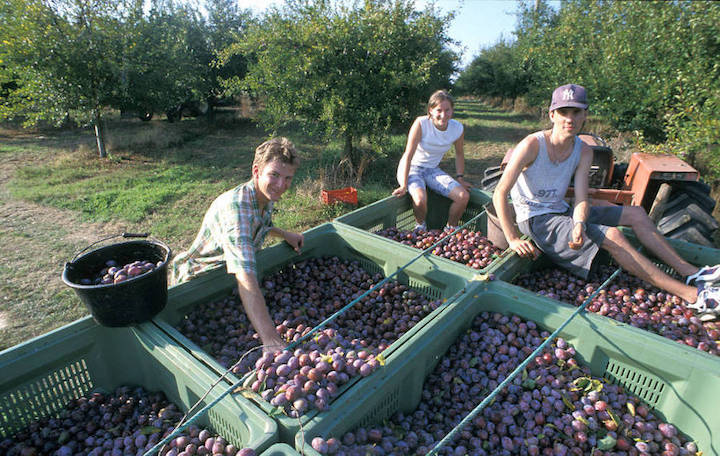
Workers at one of Nouvelle-Aquitaine’s 1000-plus prune farms, relax after gathering their harvest of ripe plums. As an officially protected French agricultural product, these plums cannot be picked before they gently fall from the trees. They are then sorted by size and packed, destined for jams, desserts. alcohol-potent digestives and ice creams. They are called Agen prunes after the town in Aquitaine that first produced them, after Lot Valley monks returned from the 12th century crusades. With cuttings from Syria, the Benedictines grew and then grafted them onto local varieties, resulting in a fruit that dried well and made excellent preserves, making the Agen prune a staple on French navy and commercial ships. Photo courtesy of Tourisme Nouvelle-Aquitaine
Whereas other cultures might view the prune as less than romantic–in Holland, the word is slang for a female body part–these plums boast a distinguished lineage, arriving in the 12th century as cuttings with Benedictine monks returning from Syria. Today, Agen prunes come labeled, like fine wine. Devout fans can follow Aquitaine’s Prune Trail, visiting hundreds of farms as well as the Prune Museum in Lafitte-sur-Lot. On a summer’s day, the smooth flavor of prune-and-Armagnac ice cream tastes like good old rum-raison.
Europe’s most Powerful Queen
It is difficult to say whether Joan or Eleanor had a greater impact on European history. On May 18, 1152, the teenage Henry of Anjou (later Henry II of England) married the feisty and sophisticated Eleanor of Aquitaine, 11 years his senior. She was the most powerful woman in Europe: first Queen of France, then Queen of England. In addition to charms that inspired a generation of troubadours, Eleanor had inherited Aquitaine, this vast and fertile region between the Pyrenees and the River Loire. Its serpentine streams, verdant valleys, orchards, and vineyards all reverted to her after her first marriage to Louis VII of France was annulled. Then, upon her marriage to Henry, it became part of the English realm. At least for a century or two.
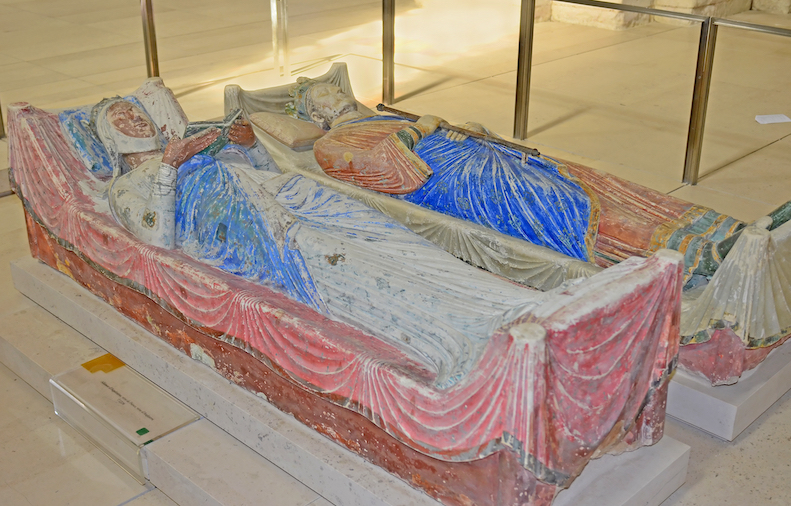
The tombs of King Henry II of England and his Queen Eleanor of Aquitaine. Eleanor died in 1204 at Fontevraud Abbey in the Loire Valley where fans of this fascinating woman travel to see her effigy next to Henry II who predeceased her. Their tombs were attacked and their bones were scattered by anti-royalists during the French Revolution and were never found. Living into her 80s, this powerful beauty nevertheless remains so popular that France issued her image on a stamp in 2004. The lands she inherited in Aquitaine remained loyal to England during the 100 Years War. She outlived all her children apart from King John of England and Queen Eleanor of Castile.
For later developments in Henry and Eleanor’s famously rancorous yet fertile union (five sons, three daughters), watch the 1968 movie classic, The Lion in Winter, starring Katherine Hepburn and Peter O’Toole. Today Eleanor’s 800-year-old tomb is in Fontevruad Abbey, Anjou, next to those of her Anjou-born husband Henry II and their son, Richard I.
Although the English claims to France provoked many a battle in the long and bloody 100 Years War (1337-1453), the region still attracts tourists from the UK. Nine centuries later, it seems anglophones still can’t get enough of the land brochures call the “Other South of France,” perhaps because it lacks the movie-star glitz of crowded spots like Cannes and St. Tropez.
Escape to the Country
Today, Nouvelle-Aquitaine is becoming a “Stop the World, I Want to Get Off” destination for transplants from hectic European capitals. Expats and visitors both gravitate to villages on nights when farmers bring their produce to downtown markets around which everyone gathers to eat, visit, and imbibe.
As south-west France becomes ever more popular, hotels feature racks of real estate and travel magazines aimed solely at newcomers. The word is getting out: less pricey, with fewer crowds than Provence to the south or Dordogne to the northeast.
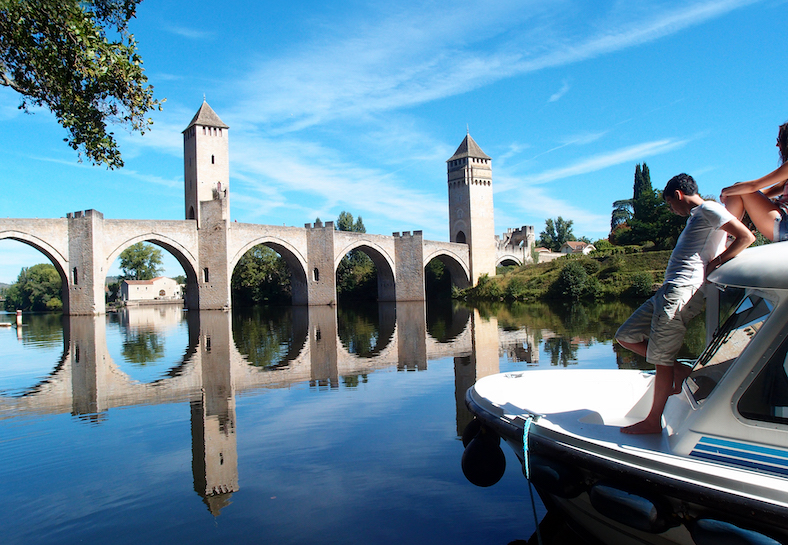
The Lot River is glass smooth as le boat nears the port town of Cahors.
Lunch with a Slice of History
Docking at a handy riverbank near Cahors, visitors follow a path leading up past a hand-painted sign where a storybook “gourmet” farmhouse awaits: a blue-shuttered structure amid a riotous rose garden. Five generations of the same family worked this farm, before switching from growing plums to raising poultry, serving, and selling farm products prepared Gascony-style–which indicates cooking in duck fat instead of olive oil, and evokes the legendary land of Gascony, a region long gone but one that lives on its cuisine. Lunch, an assortment of farm specialties washed down with dry, fruity Tariquet wine, a Gascony favorite, inspires one California diner to proclaim: “Put this in my obituary! He finally had enough foie gras.”
Fortified Towns and Pilgrimage Routes
A cycle path—one of many–runs beside the river, so working off this feast is easy for those so inclined. Hundreds of ancient, fortified towns, called bastides, often overlooking the river, draw hikers and bikers to their grid designs, a late medieval innovation credited to the English. At Villeneuve-sur-Lot, harbor stairs lead to a town of half-timbered dwellings, 13th-century towers, bridges–and pizza parlors.
Some rest houses display the sign of the shell (coquille in French) indicating a welcome for the faithful following the pilgrimage route of St Jacques (James), the Camino de Santiago, which leads over the hills into Spain. Pilgrims wearing cloaks and carrying staffs make their way past, either solo or in small groups. Devout gardeners, on the other hand, make their own pilgrimages to the national French collection of water lilies at Le Temple-sur-Lot, where Latour-Marliac, a wealthy 19th-century botanist, designed a series of shallow basins in which to grow his hybrid lilies–200 varieties in all–plus seven varieties of lotus.
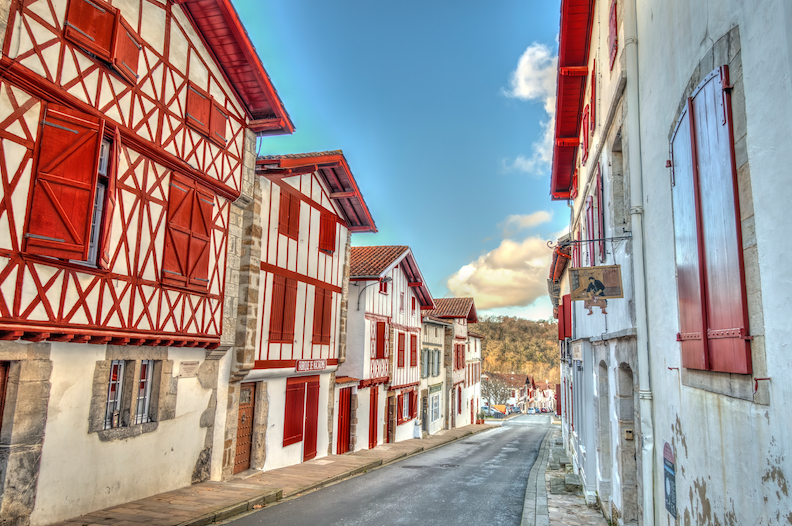
Many fortified medieval towns, or bastides, like this one in Clairence, France have the same half-timber architecture as English villages built during the Plantagenet and Tudor reigns.
At the 1889 Paris International Exposition, Latour-Marliac won his first gold medal. The next year impressionist painter Claude Monet, inspired by the beauty of these floral discoveries, ordered several varieties for his farm at Giverny. He then embarked on his most enchanting and renowned series of paintings: the water lilies. Like Monet, you, too, can order Latour-Marley bulbs for your garden.
Nouvelle-Aquitaine’s many villages blossom with elegant eateries and shops run by local artisans, hillside neo-Romanesque churches, medieval castles, private villas, and chic restaurants serving Moroccan-inspired cuisine, as diners lounge in another world, under swaths of gauzy fabric.
Viva les Friday Nights in Vianne
At village night markets like the one held every Friday in Vianne (pop. 1,300), shoppers enter an ageless world of homemade cheeses, cured meats, local Bordeaux wines and amber-smooth Armagnacs. Markets like this have endured for 750 years. The local crowd is international. Portuguese, Spaniards, Africans, plus dozens of other nationalities work in the region. Who can blame them? Consider a typical communal dinner on the Market Square: paper platters of Atlantic oysters are followed by cold duck salad, goose paté, a main course of duck confit with creamed potatoes, goat cheese with prune jam, juicy melon slices, and custard-filled Basque cake–washed down with Bordeaux reds and rosés.
Is your French history less than perfect? No problem. Between the salad and the cheese, a local man rises to toast the Black Prince (le Prince Noir). He claims to be the “le prince noir. Who?
That would be Englishman Edward Woodstock (1330-1376), Prince of the Galles, a 14th-century legend in these parts, considered the best and most ruthless English general in the 100 Years War, when Aquitaine became an Imperial Capital, and the French king was taken captive. History tells us he died at 46 “of excess” (probably from foie gras) a year before his father, Edward III.
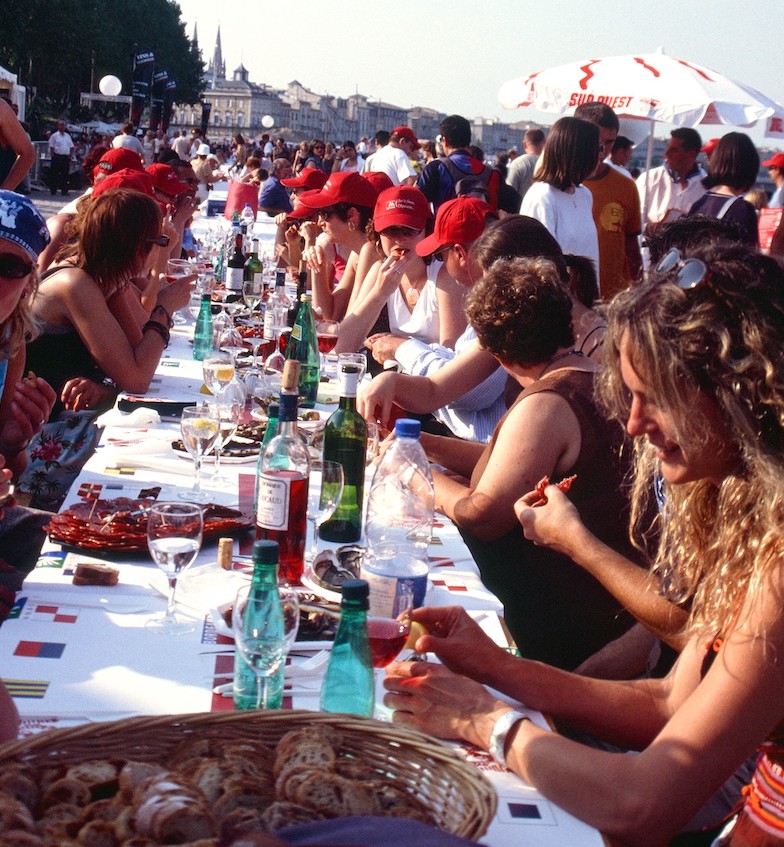
Friday Night dinner with Atlantic oysters outside at the Port of Bordeaux in Nouvelle-Aquitaine. Photo by Nancy Wigston
As the evening wears on, shouts of “Viva la Gascogne!” enliven the air. Tourists and locals alike raise their glasses to the old kingdom and its southern language, Occitan, which resembles Basque more than French and is undergoing something of a revival. In the words of one Irish friend who renounced Dublin for the slow lane in Aquitaine, “The party starts at five and lasts till 2:00 in the morning. It’s brilliant.”
After passing through a few locks, we depart the river at last and return to Bordeaux, an elegant city and bustling financial center with impressive 18th and 19th architecture and numerous ladies wearing expensive linens. It seems quite different from the lazy Lot River experience, a bit of Paris, perhaps.
But it’s here we encounter another party well underway by the old port, with lots of local wine and long tables heaped with plates of Atlantic oysters. Sunset river tours are friendly and frequent in Bordeaux, so we hop aboard for one last river experience, nostalgic already for our trip back in time.![]()
Nancy Wigston is based in Toronto. Her most recent stories for the East-West News Service focused on espionage in London and on the travels of Agatha Christie.

